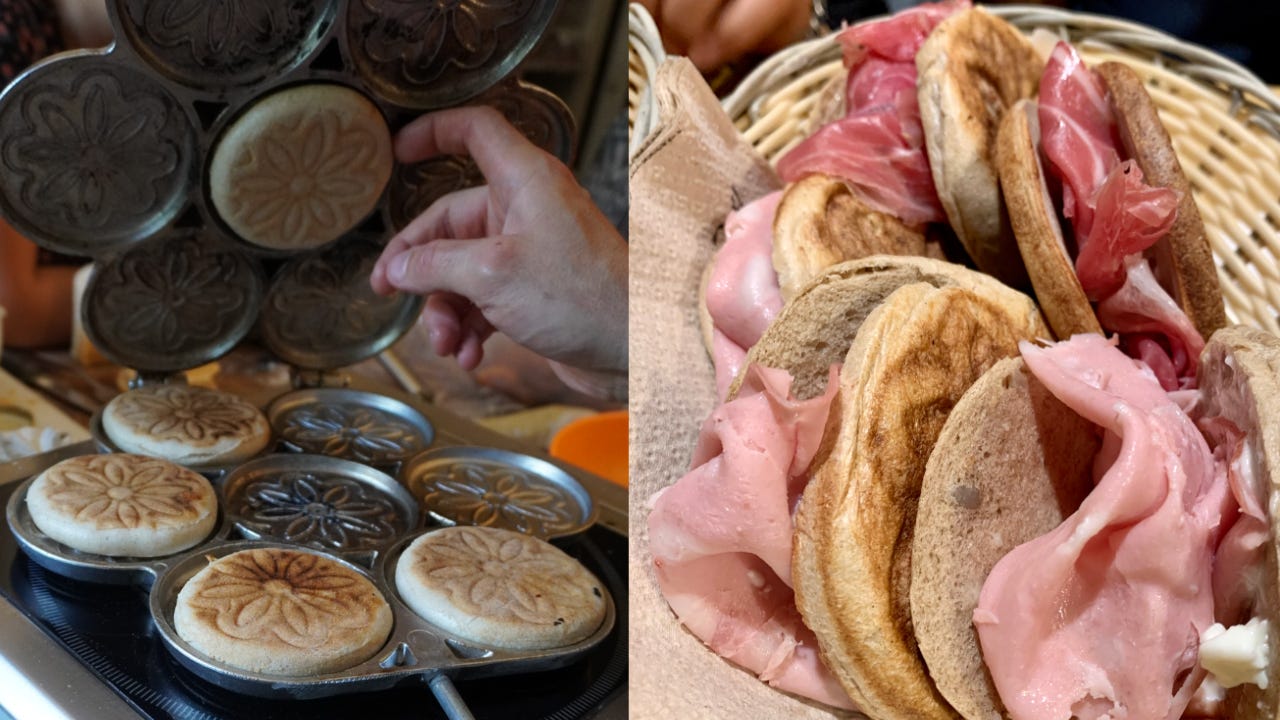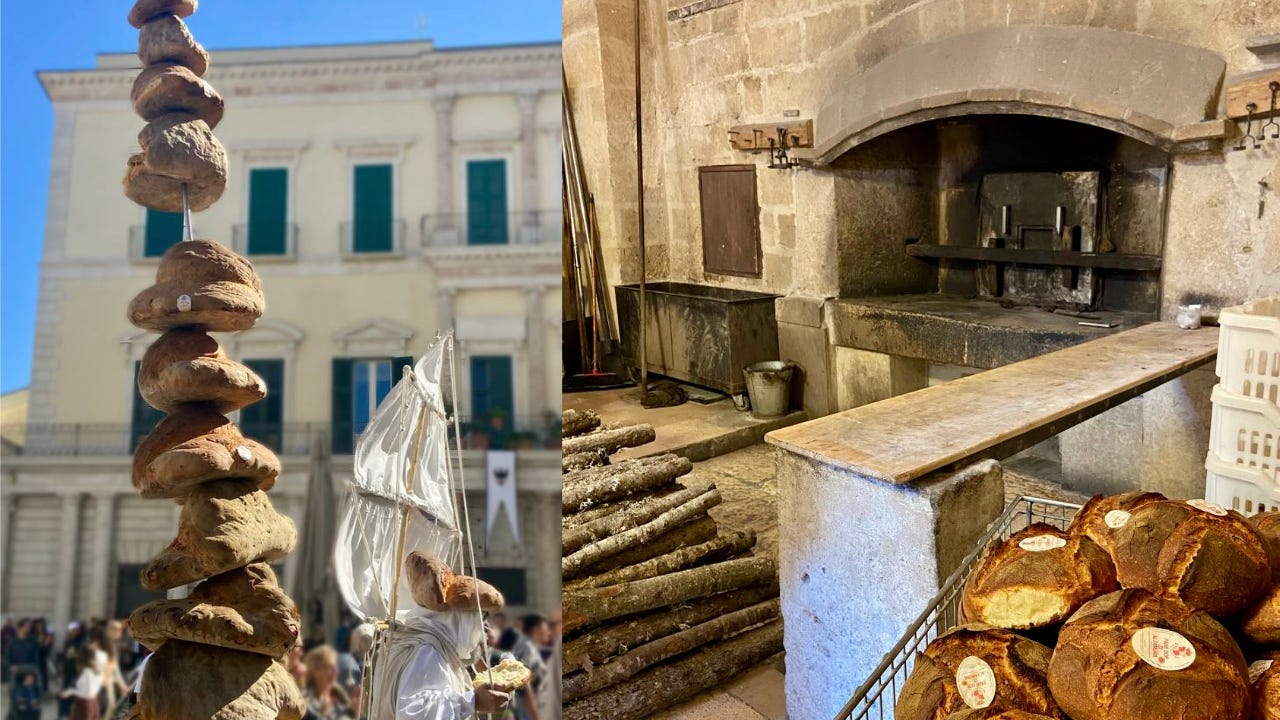The Bread Issue | Part 1
The basis of life, of our society and culture–yet often also a source of dispute
Welcome to our fresh new Cabinet of Curiosities, the source for your monthly food digest and discovery of all things curious about the world of Italian food culture!
This month we’re tackling a vast, gigantic and diverse subject: bread. Italy has enough bread types, recipes and shapes to fill an encyclopedia, so we’ll just take a small bite at it. This issue starts with a touching research into the etymology of “company” (which - you guessed it - stems from bread) by Alberto, followed by Sophie and Laís who dive deep into two ever-present bread disputes: Tigelle vs. Crescentine in Emilia-Romagna and Altamura vs. Matera bread.
Enjoy the read and let us know what you think in the comments below!
I enjoy your com-pany
By Alberto Trame: Passionate about Italy’s gastronomic and wine heritage; curious about every story in the realm of food culture.
From Medieval Latin companio, compound of com- “together with” + panis “bread”. Literally “one who breaks bread with another”.
When we use the word “company” to talk about friends or acquaintances, few of us realize that we are actually referring to an ancient and timeless practice: sharing bread.
Company, in its most general and abstract sense, is the act of being with other people — but we know that it is not just a question of mere proximity. For it to be “company” there must be a form of sharing, and its etymology represents it in the most ancestral and straightforward way: the late Latin companio is literally “the person with whom one shares bread”.
This simple yet powerful description illustrates the solidarity and camaraderie that comes with the mere act of breaking and sharing a loaf of bread.
Breaking a loaf of bread and sharing a meal with someone is indeed an act that evokes trust, friendship and intimacy — hence our desire to seek company, enjoying someone’s company.
Friendship is an indispensable good, like bread. We eat the same bread, that is, we cultivate common ideals and we share our time in valuable experiences.
In fact, by sharing the simplest food, we nourish each other.
Tigelle vs. Crescentine
by Sophie Echeverry: curious and hungry Colombian polyglot passionate about tasting & cooking world foods
In the heart of Italy, Emilia-Romagna is known as the land of Parmigiano Reggiano, Balsamic vinegar, and hand-cut pasta. It’s a place where food isn’t just sustenance—it’s a way of life – and where there’s life, there’s bread - and also a bit of controversy.
Bread in Emilia-Romagna is not just a side dish—it’s a lifestyle. The region’s rolling hills and fertile plains produce some of the best grains in Italy, and bread has been a staple for centuries. But as with most great things, opinions vary, and in this case, the battlefield is set between two seemingly innocent varieties of bread: Tigelle and Crescentine. Yes, you read that right—two breads that have caused an interesting conflict between comunes, also because they want to be the region’s favorite.
Before we dive into this flour-fueled feud, let's get some context and history. Before Italy's unification in the 19th century, Emilia and Romagna were separate regions, differing in political structure and cultural identity. This could explain why Emilia and Romagna have different ways of naming the same bread.
First things first: in Modena’s province, the terracotta discs called tegula, which comes from the Latin word tegella — meaning “lid”, would cover the dough to bake these small and round breads in an open fire. The breads baked in the now called tigella, were then called crescentine, because they were small but grew once baked. Once the bread making modernized to an aluminum tigelliera, and became more popular and accessible in Emilia and Romagna, the round bread became recognized as tigella. They are crunchy and firm on the outside, soft and chewy on the inside, perfect to slice open and stuff with lardo, salumi, or cheese.
Now, it doesn't end there. Remember the crescentine, the actual name of the round bread? Well… in other parts of Emilia-Romagna it is referred to as a puffier, fried bread. It is golden and crispy on the outside, soft and pillowy on the inside. Crescentine are often eaten with cold cuts or cheese, and they are more indulgent, as they are deep fried (often in lard).
So, which is better? It really depends on who you ask, and where you are. The real winner, of course, is anyone lucky enough to taste either. Because, let’s be real—indulging on bread is always a victory!
Altamura vs. Matera
by Laís Zimmermann: cheese nerd and food history lover
Grain cultivation and bread making has been an integral part of the culture and daily life of Altamura and Matera for centuries. Once a land of many hardships: of shepherds that left their houses for days and needed sustenance, of housewives with countless children and very few resources. Bread was the main element of the diet, obtained in a weekly ritual in which women would prepare the dough and take it to the community oven - the baker would then stamp the bread with the family’s symbol and bake all the loaves for the neighbourhood. These wood-fired ovens could bake up to hundreds of loaves at the same time. Some of them still do, the oldest ones in Altamura dating back to 1391 and 1423.
Altamura and Matera, although located in different regions, are separated by only 20km. In this short distance, a lot can change - at least according to the locals, with each city claiming with strong conviction the superiority of their bread. They can appear very similar at first glance but their differences greatly influence the final result.
Altamura’s bread was the first baked product in Italy to receive the DOP (Protected Denomination of Origin) certification from the European Union in 2003, while Matera’s bread holds an IGP (Protected Geographical Indication) status since 2008.
DOP is a stricter regulation, so Altamura bread must be made entirely from durum wheat semolina that comes from five comuni in the Alta Murgia region of Puglia, and the production must be carried out completely in the city of Altamura. The use of traditional local varieties of wheat (Appulo, Arcangelo, Duilio and Simeto) and exclusive use of sourdough starter as leavening agent reinforce the connection with the territory.
Matera’s bread, on the other hand, follows more lenient rules. The durum wheat semolina used to produce it can be sourced from the whole province of Matera, and its production can be carried out in the same area. Only 20% of the flour used needs to come from local varieties (Senatore Cappelli, Duro Lucano, Capeiti, Appulo) but the use of sourdough starter made from fresh fruits such as grapes and figs gives Matera’s bread a unique and pronounced fruity aroma.
The loaf shapes are distinct and very characteristic. Altamura’s bread is made into two shapes: skuanète in the local dialect, is the most common one - a round loaf of dough that is folded over itself, giving the final slice a sort of heart shape. Cappidd d’prèvte, “priest’s hat”, is the same round loaf of dough that hasn’t been folded.
Matera’s bread can have a shape similar to the skuanète but with three cuts on top, representing the Father, Son and Holy Spirit. There is also the cornetto, or croissant, shape: an elongated half moon folded over itself with four cuts on top, preferred by those who enjoy more of the thick, crunchy crust.
Both breads can be sold in loaves ranging from 500g to 10kg, the former being the most popular nowadays and the latter the more traditional one, when families baked one loaf per week to feed the whole household. The main quality of both products is their durability, made to last at least a week, even two - depending on the size. They not only maintain their crunchy crust and soft interior but also a deep flavour due to the quality of the flour, use of sourdough starter and wood-fired oven.






Grazie.. Non ne ero a conoscenza 👍🏻 super interessante
Loved this! Waiting for the next issue 🥖